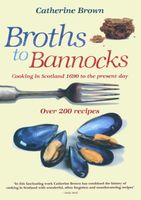Label
All
0
Clear all filters
Prue Leith's latest book is now on ckbk. Get 25% off ckbk Membership
General rules
Appears in
Published 1990
- A large cooking pot or stock pot is essential for cooking ahead for two or three meals. Tall- and narrow-shaped pots are used in professional kitchens so that the liquid bubbles up through the layers of meat and vegetables to create a flavoursome broth. It is a great thing to have a proper stock pot, but just as good broth can be made in pots designed for other jobs. I have a lightweight 14 pt (7 1) enamelled stock pot and a large 12 pt (6 1) enamelled pot and both of them have been used for the quantities in the recipes. If you are puzzled about the relationship of the pot size to the amount of liquid in the recipes [usually 6 pints (3 1)] the extra space is required for bones and vegetables which will take up much of the bulk, the liquid being only part of the volume.
- Though heavy-duty aluminium pots are hard wearing, some foods cooked in them do absorb the aluminium and there is some doubt, though as yet not conclusive, by scientists as to the safety of using aluminium pots. Stainless steel is another possibility though it does not conduct heat well unless it has a thick base with some copper. A good ironmonger will have a range of large pots or alternatively try a catering supplier who will have a more extensive range of larger pots.
- It makes more sense to make up a large quantity since it will take almost the same amount of cooking heat as a smaller amount and the broth will store well in the fridge at 5°C for three or four days. Second and third day’s broth will have a more mature, better developed flavour than the first day’s. It can, of course, be deep-frozen though it will lose some of its fragrance.
- A slow-cooker is ideal for making broth in small quantities.
- Do not disturb by stirring during the cooking time.
- Sweating vegetables (cooking gently in fat under cover to concentrate flavour), sautéing them (tossing in hot oil or fat till browned), and browning meat and bones are all a matter of preference but without these processes the flavour is blander and the colour paler. They are instinctive procedures in the professional kitchen.
- The smaller the vegetables are chopped the quicker they will release their flavour so if the broth has a short cooking time then the vegetables should be finely chopped. For longer cooking broths the vegetables need not be cut at all.
- Pack the ingredients tightly into the pot. They should not float around, hence the advantages of narrow deep pots.
- Always start with cold water.
- Vegetables should be put in the base to prevent the meat sticking. Bring very slowly up to simmering. It could take up to an hour for a large potful. This allows the meats to precipitate albuminous proteins slowly. Do not skim too soon but wait till the scum rises in a sort of grey foam. Wipe round the sides of the pot if there is a crust of scum.
- To release additional albumins add a cup of cold water.
- Do not add any aromatic herbs till this process is complete.
- At the barest simmer is how the broth should be cooked. There is no way of hurrying up the process of slow and gentle extraction of flavours. A rolling boil will break up solid ingredients and muddy the liquid. If necessary, leave the lid slightly askew to prevent the heat building up.
- Straining is best done through a fine mesh conical strainer (chinois). With a sieve of this design with a long sturdy handle and a point which rests in the bowl it is easier to hold and press out, or sieve the liquid and vegetables. An ordinary sieve is convenient enough for straining off the liquid but not so good for pressing out and sieving from bones.
- Two layers of muslin may be used to line the strainer but this is a professional procedure to produce crystal clear stock.
- If possible leave overnight in a cool place to let the fat solidify on top. Then it may be partly or completely removed, though the fat, of course, will contain some of the flavour.
- No seasonings of salt or pepper should be added to a broth pot since the reduction of the liquid will concentrate the salt flavour. Pepper loses its aroma and has a bitter taste if cooked too long.
- Do not use strong-tasting greens like cabbage or broccoli. Starchy foods, like potatoes, will cloud the broth.
- If the broth is to be reduced further for using as a meat essence the reduction should be done after straining.
- Make sure all the ingredients are the freshest and best quality you can afford.
Part of
Advertisement
Advertisement
The licensor does not allow printing of this title


